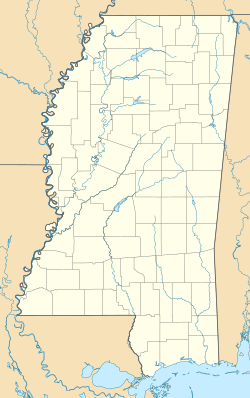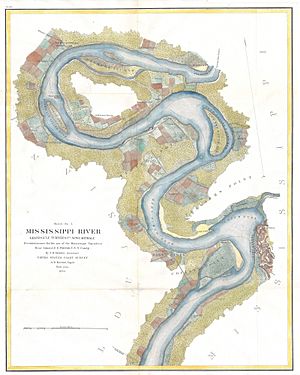Woodland Plantation (Church Hill, Mississippi) facts for kids
Quick facts for kids |
|
|
Woodland Plantation
|
|
| Location | Church Hill, Mississippi |
|---|---|
| Area | 230 acres (93 ha) |
| Built | 1838 |
| Architect | Robert Y. Wood |
| Architectural style | Gothic Revival architecture; Greek Revival architecture |
| NRHP reference No. | 78001605 |
The Woodland Plantation is a historic estate located near Church Hill, Mississippi. It is found in Jefferson County, Mississippi, and has kept its original size of 230 acres. For a long time, it has been known for growing hay for local cattle. It also has a special area where pecan trees grow.
Contents
Where is Woodland Plantation?
Woodland Plantation is easy to find. It is located just off the east side of Mississippi Highway 553. You can find it about four miles south of Church Hill. Right next to it is another historic place called the Oakwood Plantation.
The Story of Woodland Plantation
Woodland Plantation began with James G. Wood. He lived on his large 1,000-acre Auburn Plantation in Church Hill. James wanted to help his children start their own farms nearby. These farms would mostly grow cotton.
Four of these properties were Oak Grove, The Cedars, Lagonia, and Woodland. Woodland Plantation was given to James' son, Robert Y. Wood.
Building the Plantation Home
Robert Wood bought the first 224 acres for Woodland in 1837. He paid $18,000 for this land. Soon after, he built his family home on the plantation. In 1839, Robert married Virginia P. Smith. She was from New Brunswick, New Jersey. Robert bought the last six acres of the plantation in 1858. By 1860, many people were forced to work on his land in Jefferson County.
Robert Wood also owned another large farm called Ursino Plantation. This was in Warren County, Mississippi. His brother, Edgar, helped him manage it. Ursino was started in 1836. James Wood and Robert bought over 2,000 acres of land for it. This land was near Davis Bend, Mississippi, south of Vicksburg. They bought it from Joseph Emory Davis, who owned Hurricane Plantation. Ursino was next to Jefferson Davis' Brierfield Plantation. By 1842, Ursino had many cattle and people forced to work there. By 1860, even more people were forced to work on Robert's land in Warren County.
Changes After the Civil War
After the Civil War ended in 1866, Robert Wood faced money problems. He sold Woodland Plantation for $10,000 to Ann L. Foster. By 1871, Robert was in great financial difficulty. He sold Ursino Plantation for $100,000 to Ben Montgomery. Ben Montgomery was a former enslaved person from Hurricane Plantation. Robert and his wife Virginia then moved to Woodburn, another plantation in the Church Hill area. They lived there until they passed away in 1882. Woodburn belonged to Robert's brother, Walter Wood.
Later, Ann Foster's daughter, Mary A. Foster Lloyd, owned Woodland by 1879. However, Mary could not repay a loan. So, she had to give ownership of Woodland to Jefferson College. The college was in Washington, Mississippi, and had given her the loan.
From 1889 to 1936, Woodland Plantation had several different owners. During this time, the property became quite run down. In 1889, Ann L. Foster bought Woodland for a second time. She bought it from Jefferson College for $1,800. Around 1910, a tiny insect called the boll weevil caused big problems. It destroyed the cotton crops, which had been the main crop for a long time. After cotton farming stopped, Woodland became known for growing hay for cattle and for its pecan trees.
In 1936, Philip Heath Marble bought Woodland Plantation. He worked hard to fix it up and make it beautiful again. His daughter, Phyllis Marble, lived there for many years. She sold the plantation in 1974.
Architectural Style
The main house at Woodland Plantation has a unique look. Its style combines two different types of architecture. It shows elements of both Gothic Revival architecture and Greek Revival architecture.
The house has one and a half stories. It originally had porches on both the front and back. These porches also connected to a separate kitchen building. Inside, there was a large center hall, about 35 by 15 feet. On each side of this hall were two big rooms, each 19 by 19 feet. Some of these rooms had fancy marble fireplaces, while others had wooden ones. The ceilings on the first floor were very tall, about 12 and a half feet high. There were also special "pocket doors" that could slide into the walls between the front and back living rooms. Some windows had "jib doors" underneath them. These allowed direct access to the porches. A staircase in the center hall led up to the second floor. This upper floor was originally one large open room.
Woodland Plantation has been recognized as an important historic site. It has been listed on the National Register of Historic Places since February 22, 1979.




